Archived - Performance Report 2004 – 2005
Archived information
This Web page has been archived on the Web. Archived information is provided for reference, research or record keeping purposes. It is not subject to the Government of Canada Web Standards and has not been altered or updated since it was archived. Please contact us to request a format other than those available.
Date: March 2006
PDF Version (1.15 Mb, 30 Pages)
Help on accessing documents in PDF format
can be obtained on the help page.
Table of Contents
- Management Statement
- Performance Measurement
- Giant Mine
- Table 3: Current Status of Priority Class 1 Sites - 2005
- Table 4: Types of Activities Undertaken at Sites - 2001-2005
- Future Directions
Management Statement
I am pleased to present the Northern Affairs Program (NAP), Contaminated Sites Program (CSP) fourth annual Performance Report, for the 2004-2005 fiscal year. We made significant progress this year in managing contaminated sites in the North for which we have responsibility. For example, we increased the number of sites where ongoing care and maintenance, site assessment or site remediation work took place. These efforts are helping the Program to reach its overall goal of reducing the risk to human and environmental health associated with the sites that we manage. In 2004-2005, our program spent approximately $66.4 million achieving a number of key results shown in the table below.
| Type of Activity | Number of Sites |
|---|---|
| 2004-2005 | |
| Care and maintenance | 9 |
| Site assessment work | 20 |
| Consultations | 13 |
| Remediation work | 14 |
| Site monitoring | 19 |
In the coming year we will continue to work toward further site remediation and liability reduction. We are grateful for the funds the Program receives from the Federal Contaminated Sites Accelerated Action Plan (FCSAAP) Program, as this financial injection greatly enhances our ability to accelerate the remediation of our 68 known contaminated sites.
We accomplished many of the site-specific goals we set out to achieve last year, and though we successfully completed many of them, such as completing site remediation at Kittigazuit Bay and commencing remediation at Colomac Mine, not all of our goals were achieved. The commitment was made to submit a Giant Mine Remediation Plan to the regulatory authorities; however, this did not occur in the reporting period. Despite such challenges, we are proud of what we have accomplished to date, and are dedicated to continuing our efforts to improve the management of sites under our care by:
- Assessing additional sites where contamination and liability are unknown;
- Completing remediation at sites that pose human and environmental risks;
- Making positive economic and social contributions to the communities in the North where our sites are located; and
- Being transparent and fiscally responsible.
We also set a number of program management goals last year which we were successful in achieving, including:
- Securing long-term funding for the implementation of closure plans at priority sites;
- Conducting a program/project management review;
- Implementing a risk management tool and rolling out the process to most sites;
- Drafting a Procurement Strategy; and
- Updating the Contaminated Sites Corporate procedures.
I would like to thank the CSP staff and our partners for their dedicated work throughout the fiscal year. Without their commitment to the CSP, none of our accomplishments would have been possible.
I invite you to read this year's Performance Report for an in-depth perspective on the CSP's progress. A list of acronyms can be found at the end of the report to assist you.
To ensure we continue to meet the needs of our stakeholders, I also invite you to provide comments and feedback on this report. [Note 1]
Liseanne Forand
Assistant Deputy Minister
Northern Affairs Program
Indian and Northern Affairs Canada
Report Coverage
This Performance Report presents the results of Indian and Northern Affairs Canada's (INAC) Northern Contaminated Sites Program (CSP). The program operates in Canada's three territories and results are reported for the period April 1, 2004 to March 31, 2005. Additional information on CSP activities can be found on our website and in previous annual performance reports.
Profile of NAP Contaminated Sites Program
INAC is the custodian of most federal lands in the North, and CSP is responsible for managing contaminated sites in the three territories to ensure that human and environmental health is protected.
Figure 1: Map of Priority Sites
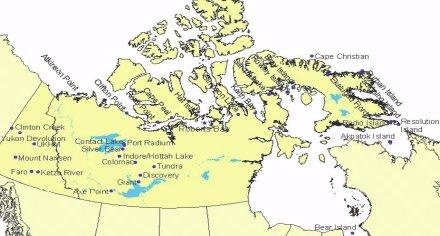
As of March 31, 2005, 370 contaminated sites (assessed and suspected) in the North require action including assessment, remediation or risk management. Figure 1 identifies where our priority sites are located in the North.
A dedicated team of CSP staff manages these sites. As a result of a functional analysis conducted in 2003-2004, CSP obtained funding in 2004-2005 for several new positions in all of the regions and headquarters, including:
- Yukon: Director; Faro Mine Manager; Type II Mines Manager; Administrative support.
- NWT: Director; Program Manager; Administrative support.
- Nunavut: Director; Program Analyst; Project Manager; Administrative support.
- Headquarters: Director; Manager of Engineering Services; Senior Engineer; & Administrative support.
Please note that not all of these positions were filled during the reporting period but will be staffed in 2005-2006.
Overall, there was a significant increase in the number of program staff over the fiscal year, from 23 in 2003-2004 to 34 in 2004-2005. Staff are located at INAC Headquarters (HQ) in Gatineau, Quebec (3.5), and in three regional offices in the Northwest Territories (NWT) (24), Yukon (7) and Nunavut (3). The largest increase in staff occurred in NWT where 5.5 positions were added.
A Memorandum of Understanding (MOU) was negotiated in 2004-2005 between CSP and Public Works and Government Services Canada (PWGSC), whereby PWGSC would act as a strategic partner to the Program providing services in project management and contracting. The MOU will be signed in 2005-2006, and will provide operational support to the regions and some support to HQ. This MOU is another output of the functional analysis conducted in 2003-2004.
With the devolution of land and resource management responsibilities in the Yukon, and potential devolution in NWT and Nunavut, INAC is working with the territorial governments, First Nations and Inuit partners to manage contaminated sites.
Yukon's devolution agreement came into effect in 2003. Under this agreement, INAC is responsible for cleaning up contaminated sites in cooperation with the Yukon, and once sites are remediated they will be transferred to the Yukon Government. Smaller waste sites were transferred to the Yukon and INAC contributes $2 million/year for ten years for clean-up, which began in 2003.
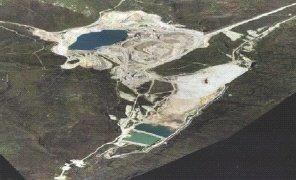
Faro Mine Site, Yukon.
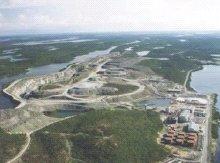
Colomac Mine Site, NWT.
The Federal government has entered into devolution discussions with the territorial and Aboriginal governments in the NWT, including discussions on the remediation of waste and contaminated sites. A framework agreement was signed in 2003-2004 and in 2004-2005 regional contaminated site program staff participated in departmental discussions to support the negotiating tables. A preliminary look at all sites was initiated to confirm site status, remediation requirements and preliminary remediation estimates. An Agreement-in-Principle is expected to be negotiated for 2005-2006. Further information on devolution in the NWT.
The Government of Nunavut continued to raise the devolution of lands and resources as one of its top priorities. In December 2004, Canada and the three northern Premiers announced their intention to jointly develop a Northern Strategy and released a framework document for public consultations. The Prime Minister also announced that Canada would seek a mandate for Nunavut devolution negotiations within a year and set a goal of reaching a final agreement by December 2008. This commitment was key in securing The Nunavut's Government support for the Northern Strategy.
Vision
INAC will contribute to a safer, healthier, sustainable environment for First Nations, Inuit, and Northerners by striving to preserve and enhance the ecological integrity of the environment through the implementation of a Contaminated Sites Management Policy. Under this policy, the CSP's vision is to:
Manage contaminated sites in a cost-effective and consistent manner and to reduce and eliminate, where possible, risk to human and environmental health and liability associated with contaminated sites.
The CSP has established six strategic objectives to guide its activities:
- Meet legal obligations;
- Identify/assess contaminated sites;
- Provide a framework for planning purposes;
- Remediate National Classification System (NCS) Class 1 sites by 2027;
- Promote socio-economic benefits; and
- Apply polluter pays principle.
How CSP achieves its vision and strategic objectives are reported in the following pages of this Performance Report. Figure 2 summarizes our key performance highlights.
Figure 2: CSP Performance Highlights
| Legend | |
|---|---|
|
|
Improved performance |
| No change in performance | |
|
|
Performance declining, requires action |
| Program Management | Financials |
|---|---|
|
|
Expenditures Liabilities |
| Priority Sites | Polluter Pays |
|
|
|
| Socio-Economic Benefits | |
|
See Resolution Island from this document |
NAP Contaminated Sites Management and Governance
Overall responsibility for the CSP rests with the Deputy Minister, INAC, and the Assistant Deputy Minister, NAP. Key aspects of the CSP management and governance structure can be found at: NAP Contaminated Sites Management
Performance Measurement
The Program's progress in meeting its six strategic objectives can be found in the following sub-sections of this report:
- Management
- Policy and Regulations
- Program Management
- Contaminated Sites Inventory - Priority Sites
- Financials
- Social and Economic Benefits
- Polluter Pays Principle
Progress Achieved
Management
Policy and Regulations
The context in which the CSP must operate consists of applicable regulations, policies, and technical guidelines and standards. The Canadian Environmental Protection Act (CEPA), and the Fisheries Act (FA) are the most applicable pieces of federal environmental legislation related to contaminated sites. The CSP is also influenced by important jurisdictional legislation including but not limited to the Northwest Territories and Yukon Waters Acts and Regulations, and the Nunavut Waters and Nunavut Surface Rights Tribunal Act, as well as Treasury Board Secretariat (TBS) policies and guidelines. There were no legislative or policy changes during the fiscal year that affected the Program's operations, and no issues with regard to conformance or compliance with existing policies and regulations were noted. A site in Nunavut did receive a warning letter related to the improper storage of Polychlorinated Biphenyls (PCBs). Corrective action has been taken and the PCB contaminated soil stored in barrels on the site has been removed and disposed of in accordance with regulatory requirements.
INAC's own Contaminated Sites Management Policy is intended to provide guidance for the management of contaminated sites under INAC's custodial responsibility. No changes were made to the Policy in the fiscal year. The Policy is part of the Contaminated Sites Program Management Framework, which is discussed in more detail below.
Program Management
Conaminated Sites Program Management Framewok
Since 2002, CSP has developed and implemented a comprehensive Contaminated Sites Program Management Framework that includes a Contaminated Sites Management Policy, a long-term plan and the NAP Contaminated Sites Results-based Management and Accountability Framework (RMAF), and a set of corporate procedures that document all program processes and procedures to promote the consistent application of the management framework across all regions. During the fiscal year, CSP developed its second Contaminated Sites Management Plan that was submitted to TBS in January 2005. This plan is essential to, and an output of, the NAP Contaminated Sites Management Framework. It outlines CSP's approach for achieving program objectives over the next ten years, and outlines plans for an $850 million investment to address 44 sites, including the Department's most significant liabilities. Of these sites, 32 will be remediated and 13 will be advanced to a stage of active remediation in the next ten years.
Gap Analysis
A gap analysis of the CSP program and project management practices was conducted over the last two fiscal years. The scope of the gap analysis included all funded projects in the 2003-2004 fiscal year, and the objectives were to:
- Implement the NAP CSP internal audit program;
- Establish a baseline of program and project management practices in the regions by identifying gaps that require management attention and resources; and
- Identify best practices that can be shared between projects and regions.
Recommendations were made in the following areas:
- Identifying & selecting options
- Aboriginal involvement in decision making & project implementation
- Procurement Strategy
- Cost estimation
- Human resources
- Budgetary management
- Quality Assurance/Quality Control
A number of these recommendations led to special projects in the 2004-2005 fiscal year, some of which are discussed below.
Remediation Approaches Workshop
INAC prepared a discussion paper and convened a workshop of experts in September 2004 to review the DEW Line clean-up protocol and assess its effectiveness and appropriateness as it relates to INAC military sites. As a result, an Abandoned Military Site Remediation Protocol was developed in March 2005.
Risk Management
As the complexity and scale of sites in the CSP contaminated sites inventory have increased, there has been a collective understanding that current tools are not adequate and do not provide enough detail and transparency to ensure that risks are identified and addressed in a consistent manner. A new risk management procedure was implemented in 2004-2005, the objectives of which are to provide:
- A consistent methodology for developing an inventory and evaluating the many different types of risk at contaminated sites;
- A process to ensure that no high risks are missed; and
- A basis for prioritizing risk mitigation or control activities within and among sites.
To facilitate the design of the procedure, a Project Team and Advisory Group were formed, and a background paper was prepared. A workshop was held in June 2004 to validate the draft procedure. Based on input received at this workshop, the procedure was modified, finalized, and incorporated into a new risk management tool that is integrated with the contaminated/waste site database (see Figures 3 and 4).
The central component of the procedure is a risk management workshop, which brings together project managers, key staff, and external experts to assess the risks of various aspects of each site. The Program has developed information technology tools and guidance documents and has implemented the procedure for nine sites in the Yukon and NWT through these workshops. Workshops are planned in Nunavut for the next fiscal year.
Figure 3: Risk Management Data Screen
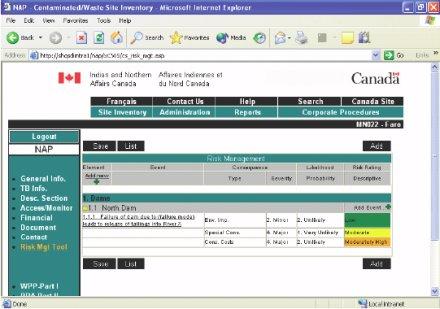
Figure 4: Risk Management Report Screen

Detailed Work Planning Template
The lack of consistent standards for work planning or project management was identified as an issue in 2004-2005. In order to address this, a template for detailed work planning was designed to facilitate annual review and approval processes, as well as to provide project managers with a tool for tracking progress.
Procurement Strategy
At the beginning of the fiscal year, it was determined that contribution agreements should no longer be used for funding remediation programs. In the fall of 2004, work began on a new Procurement Strategy. A baseline of different procurement measures was mapped out and an open and competitive process was adopted.
The new Procurement Strategy was successfully implemented in NWT during the reporting period. In Nunavut, the Strategy will be further refined through negotiations with Nunavut Tunngavik Incorporated (NTI) in 2005-2006. The Strategy is not applicable in the Yukon because of devolution.
Strategic Work Planning Action Team (SWAT)
The new risk management procedure, detailed work planning template, and Procurement Strategy were implemented together in what has been termed a SWAT approach to help the regions with risk management, work planning, and procurement planning all at the same time. Workshops addressing these three items were held in Yellowknife, NWT in January 2005. The risk management procedure was also implemented at workshops held in Whitehorse, Yukon in March 2005. Workshops in Nunavut will be conducted in 2005-2006.
Contaminated Sites Inventory
Conaminated/Waste Site Database
In order to track the progress made by the Program on its contaminated sites, NAP maintains a contaminated/waste site web-based database. Consistent use of the database across all regions remains a challenge. No additional training on the database was provided in 2004-2005 to alleviate this challenge. The addition of a geographic information system (GIS) component to the database was scheduled for 2004-2005 but is now expected to occur in 2006-2007. This added feature will enhance our database capabilities in terms of mapping and reporting.
In addition to contaminated sites, NAP's contaminated/waste site database includes information on waste sites and other physical hazards that represent a potential human health and safety risk and a liability for INAC. While not considered in the TBS Contaminated Sites Management Policy, physical hazards must also be managed by NAP.
As of March 31, 2005, there were 1,826 sites (contaminated and physical hazards) in the NAP Contaminated/Waste Sites Inventory.
Of these 1,826 sites:
- 984 (54%) have been assessed and require no further action or have been remediated, reducing the risk to human and environmental health and associated site liability;
- 830 (45%) still require action including assessment, remediation or risk management; and
- 12 (4%) are contingent liabilities.
Of the 830 sites that still require action, 345 (up two from last year) have been assessed and 485 still need assessment or site inspections to determine the level of contamination, if present. Table 1 identifies the number of assessed and suspected contaminated sites and physical hazards by region. Compared to the previous year, the number of assessed contaminated sites has increased by two (both in Nunavut). The number of assessed physical hazards has remained the same. The number of suspected contaminated sites has decreased by ten overall for the Program. The changes are a result of three less suspected contaminated sites in NWT, a decrease of six in Nunavut and the removal of even contingent liabilities previously included in the table.
Definition from INAC's policy:
Waste Sites: a site where materials have been deposited (e.g. garbage, vehicles, hazardous materials) or where hazards exits (e.g. open adit). A waste site may or may not be a contaminated site.
Table 1: Number of Contaminated (C.S.) and
Physical Hazard (P.H.) Sites - 2005
| Region | C.S. | P.H. | C.S. | P.H. | |||
|---|---|---|---|---|---|---|---|
| Assessed | Sub-Total | Suspected | Sub-Total | Total | |||
| Yukon | 11 | 43 | 54 | 14 | 61 | 75 | 129 |
| NWT | 29 | 127 | 156 | 179 | 77 | 256 | 412 |
| Nunavut | 28 | 107 | 135 | 109 | 45 | 154 | 289 |
| Total | 68 | 277 | 345 | 302 | 183 | 485 | 830 |
The Canadian Council of Ministers of the Environment (CCME) National Classification System (NCS) is used to classify the level of concern with contamination at a particular site. Sites are classified according to the following categories:
Class 1: Action Required
Class 2: Action Likely Required
Class 3: Action May be Required
Class N: Action Not Likely Required
Class I: Insufficient Information
Contingent Liability
A contingent liability is an existing condition or situation involving uncertainty concerning possible gain or loss to an organization that will ultimately be resolved when one or more future events occur or fail to occur. Resolution of the uncertainty may confirm the acquisition of an asset. The reduction of liability, the loss, impairment of an asset, incurrence of a liability and the party responsible for clean-up has not been determined.
Last year there were 11 reported contingent liabilities and this year there are 12.
Table 2 identifies the total classification of sites compared to the previous two years. Overall the number of classified sites has increased by three from the previous year, with the most significant changes occurring in Nunavut. Sites in Nunavut were reclassified based on new assessment information and this led to some changes in CCME classification between the two years. Two sites in Nunavut, Spears Lake and McGregor Lake were also classified for the first time as Class 2 sites.
Table 2: CCME Classification of Sites, 2002-2005
| Class | 2002-03 | 2003-04 | 2004-05 |
|---|---|---|---|
| 1 | 42 | 43 | 44 |
| 2 | 15 | 14 | 19 |
| 3 | 5 | 9 | 5 |
| N | 1 | 0 | 0 |
| I | 0 | 0 | 0 |
| Total | 63 | 66 | 68 |
United Keno Hill Mines
The United Keno Hill Mines (UKHM) property is located within the Keno Hill, Galena Hill, and Sourdough Hill area of central Yukon approximately 350 km north of Whitehorse.
This project is funded by INAC and co-managed by the Government of Yukon and INAC. (INAC is obliged to remediate all contaminated sites listed in Chapter 6 of the Yukon Devolution Transfer Agreement, which came into effect in April 2003). The Government of Yukon took over care and maintenance activities in June 2003.
In April 2004, this property was put into receivership jointly by the Government of Yukon and INAC. INAC and the Government of Yukon will be involved with the receiver on establishing options dealing with the existing liabilities of the site and how they will be considered in any sale.
Work done at UKHM in 2004-2005 includes:
- Care and maintenance: a substantial portion of the site's budget went towards continued water treatment, conducted at five separate locations, and site security activities.
- Regulatory Approvals: $1 million was spent under this activity, mostly related to legal and receivership costs. Some permits and licensing were also required for the offsite removal, transport and disposal of PCBs and hazardous chemicals.
- Site investigation and assessment: water treatment optimization.
- Site remediation: the tailings dam spillway was lowered to improve the physical stability of the dams, as well as removal of hazardous chemicals and PCBs, and power-line remediation (removal of abandoned poles and wire).
- Monitoring: ongoing water monitoring.
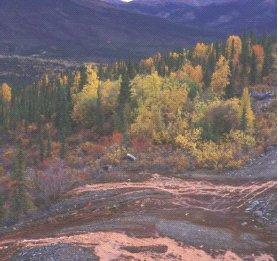
Galkeno 300 discharge
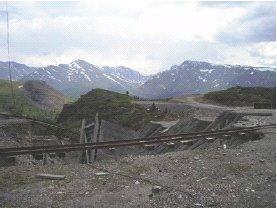
Keno 700 site
Giant Mine
In March 2005, the Government of Canada and the Government of the Northwest Territories entered into a Cooperation Agreement regarding the Giant Mine Remediation Project. Under the Agreement, the two governments committed to work together on the remediation of Giant Mine. An office under INAC management has been established, however, there will be additional staff from the NWT Government, which are needed to implement an effective care and maintenance program for the site and finalize a cost-effective remediation plan.
An oversight committee will also be established to oversee the Cooperation Agreement, and provide general direction to the Interim Office. The committee will have equal federal and territorial representation and report to the Ministers of each government.
Both parties agree that the underground freezing method is the preferred option for addressing the arsenic trioxide dust stored underground at Giant Mine, and both parties have agreed to maximize northern economic development opportunities in carrying out the Giant Mine Remediation Project.
Prior to the signing of the agreement, staff at the Giant Mine Site had been integrating the project description for the long-term management of the arsenic trioxide dust with the surface abandonment and reclamation plan. This work will assist the Interim Office in developing the final Giant Mine Remediation Plan, expected to be completed in 2005-2006.
Other activities conducted at the site in 2004-2005 include:
- Care and maintenance: pumping and treating contaminated water, and inspections and monitoring of accessible bulkheads that provide arsenic trioxide containment.
- Site investigation and assessment: collection of additional baseline data for the site and geotechnical investigations of the chambers and stopes containing arsenic trioxide.
- Consultation: ongoing communication activities through the Community Alliance, media visits to the site by Global TV and the Nature of Things, and visits by local community groups such as the Yellowknives Dene First Nation (YKDFN).
- Monitoring: ongoing water monitoring.
After a competitive contracting process, an Aboriginal and Northern company joint venture contractor was awarded the contract for care and maintenance of the site. This company will assume full responsibility for care and maintenance at the site, including security, in July 2005.
For background information on the Giant Mine Site.

Water Treatment Plant
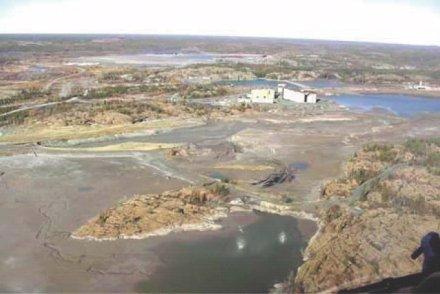
South Tailings Pond
Resolution Island
Resolution Island, located at the south-eastern tip of Baffin Island, has been under active remediation since 1997. Remediation is scheduled for completion in 2005-2006, followed by a 25-year comprehensive monitoring plan. Activities conducted in 2004-2005, which represents the second year of the revised remediation plan, include:
- Logistics, including mobilisation and demobilisation of the camp as well as refuelling
- Excavation of contaminated soil at various locations around the island
- Containerisation of PCB contaminated soil and shipment south for destruction
- Production of clean fill
- Remediation of old dump sites as well as a Tier II landfill
- Construction of two non-hazardous landfills ris as required
- Management of physical deb operators
- Training of junior
- Analytical work
- Permanent barrier testing
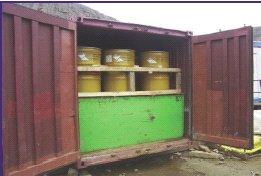
Contaminated Debris Packaged for Shipment at Resolution Island
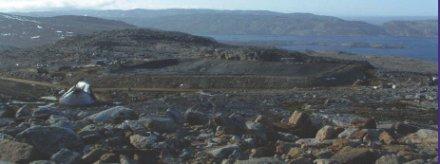
Resolution Island Tier II Landfill
Silver Bear Mines
Silver Bear Mines experienced a considerable increase in spending in 2004-2005 - from just under $40,000 in the previous year to over $1 million in 2004-2005. Increased spending is related to detailed investigations and engineering studies preparing the specifications for remediation, and site mobilisation for clean-up. Specific activities include:
- Care and maintenance: signs posted to warn people about the risks of entering the site and buildings secured to prevent entry.
- Regulatory approvals: submission of a land use permit application to incinerate waste oils and fuels onsite.
- Consultation: consultation with the affected First Nations in the Sahtu and Tlicho land claim areas.
- Site investigation and assessment: completion of detailed studies to refine remediation requirements and selection of remediation options.
- Site remediation: waste oil incineration and collecting and packaging laboratory chemicals to be disposed offsite at an approved facility.
- Monitoring: aquatic studies to determine baseline conditions as well as the potential for environmental impacts from the site.
Colomac
Colomac is situated near the Indin River and Indin Lake within the traditional lands of the Tlicho. The Bathurst caribou herd migrates through the area annually on its way to and from its calving grounds; caribou continue to be a major staple of the Tlicho diet.
There are numerous human health and safety and environmental risks at Colomac associated with chemical and physical hazards. The main chemical hazards are those posed by the contaminated tailings, hydrocarbon spills and hazardous materials. The physical hazards are associated with open pits, quarries, waste rock piles, buildings and other infrastructure.
The current plan for remediating Colomac is as follows:
- Environmental assessment and licensing - 2004-2006
- Tailings containment area remediation - 2006-2008
- Water discharge - starting in 2008
- Other remediation - 2004-2009
- Confirmatory monitoring - 2008-2013
INAC submitted its remediation plan for Colomac to the Mackenzie Valley Land and Water Board (MVLWB) on March 31, 2004. This plan was made publicly available in 2004-2005 by the MVLWB and was well received by the Tlicho communities, government departments and other people concerned with the project. The Board determined that there would be no significant impacts on the environment once the plan is carried out, and decided that an environmental assessment of the plan would not be needed.
The project proceeded directly to the licensing stage. The Board scheduled a public hearing on the water license application for November 4 and 5, 2004. No concerns were submitted and the Board agreed to cancel the hearing. The new water license was approved by the Board in March 2005.
Other activities conducted in 2004-2005 include the removal of tailings-contaminated soil near the mill; construction of a diversion ditch around the tank farm area that will ensure that clean surface water does not come in contact with the tank farm during remediation activities (demolition of the tank farm was completed in 2003-2004); construction of a "barrier wall" between the tank farm and Steeves Lake; and construction of a land treatment unit (LTU) that will remediate oily soils from the tank farm area using natural bacteria to break down the oil in the soil. Work also continued on the Enhanced Natural Remediation (ENR) option for treating tailings water.
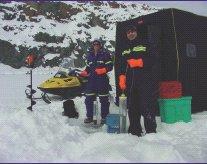
Monitoring at Colomac
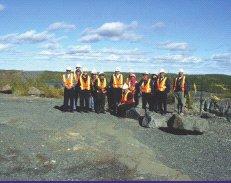
Tlicho Site Visit to Colomac
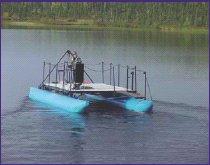
Colomac Enhanced Natural Remediation (ENR)
Discovery
Gold was mined and processed at the Discovery Mine site, located north of Yellowknife, from 1949 to 1969. Reclamation activities began in 1998 and continue today. Activities conducted in 2004-2005 include additional assessment work as well as the submission of a Remediation Plan to the Mackenzie Valley Land and Water Board (MVLWB). Approval of the Remediation Plan was obtained quickly because the tailings were already covered. The remediation contractor mobilized to the site in March 2005 via a winter road. Over $3 million was spent on site remediation during the reporting period, and some major demolition and clean-up work will occur in 2005-2006.
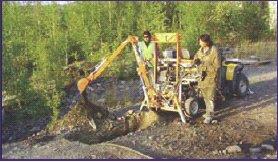
Excavating contaminated soil at Discovery
Clinton Creek
The Clinton Creek Mine is located approximately 100 km northwest of Dawson City. In 2004-2005, a human health risk assessment of the hazard of airborne asbestos was completed, which will allow a decision to be made on acceptable final closure options for the tailings area and other areas where asbestos is evident.
This year also saw the completion of the Clinton Creek stream stabilization project, which began in 2002. Completion of the project was previously delayed due to unfavourable weather conditions. Part of this project included the installation of a cofferdam to allow for in-stream construction. In 2003, this procedure facilitated the collection and release of approximately 1,500 fish into either Hudgeon Lake or downstream of Wolverine Creek where there were sufficient water levels. This same procedure was followed in 2004 in order to protect fish from the activities taking place on the Clinton Creek Mine site.
Demolition of some of the site's physical hazards (e.g. crusher building, mill area infrastructure, ammonium nitrate/fuel oil [ANFO] storage area, tramway towers) also commenced in 2004-2005.
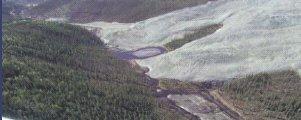
Clinton Creek Mine Tailings
Priority Sites
Priority sites are those that receive an NCS Class 1 rating, which indicates that action is required. These sites have higher associated risks than other sites, and are the focus of many CSP activities. Table 3 on the following page illustrates the status of priority sites according to the Contaminated Sites Management Working Group (CSMWG) ten-step process, outlined below. [Note 2]

Of the 37 identified priority sites, five have progressed to a higher step in the ten-step process compared to last year, including:
- UKHM
- Mount Nansen
- Tundra-Taurcanis
- Silver Bear
- Discovery
Twelve sites have regressed in the ten-step process.
Ekalugad Fiord and Sarcpa Lake (NU) did have some remediation work done on site (e.g. consolidating and crushing debris), however, the majority of the work at these sites was on completing their remediation strategy, therefore, they have been lowered to Step 7. The remaining DEW Line sites require Phase 3 assessment and this will not be accomplished over the next several years so they have been lowered to Step 4.
Three sites are new to this priority list:
- Indore Gold Mine/Hottah Lake Mine, NWT (completed Step 4);
- Hat Island, Nunavut (completed Step 4); and
- Yukon Devolution sites, which consist of a number of sites grouped under this name (completed Step 7 and Step 8 in progress).
Hydrometric stations were removed fromlist and are now classified under YukonDevolution for the clean-up of the few remaining sites. One site, Bernard Harbour Nunavut, was removed from this priority list and has been reclassified as a Class 2 site.
Depending on where a site is along this ten-step process, different activities tato meet the site's objectives. Table 4 illustrates the number of sites where various types of activities took place over thfiscal years. In all activities except consultations and site monitoring, there hbeen an increase in the number of sites undertaking activities compared to the previous year.
During 2004-2005, remediation took place at 13 [Note 3] NCS Class 1 sites, up from nine sites in the previous year. These sites included:
Yukon
- Faro Mine
- Clinton Creek Mine
- Yukon Devolution
- UKHM
Nunavut
- Resolution Island
- Ekalugad Fjord
- Sarcpa Lake
NWT
- Giant Mine
- Port Radium
- Tundra-Taurcanis
- Silver Bear
- Colomac
- Discovery
Table 3: Current Status of Priority Class 1 Sites - 2005
| Site | Region |
1 Iden- |
2 Histo- |
3 Initial Testing |
4 Clas- |
5 Detai- |
6 Reclas- |
7 Develop Reme- diation Risk Mgt. Strategy |
8 Imple- |
9 Confir- |
10 Long- |
|---|---|---|---|---|---|---|---|---|---|---|---|
| Faro | YK | ||||||||||
| UKHM | YK | ||||||||||
| Mount Nansen | YK | ||||||||||
| Ketza River |
YK | ||||||||||
| Clinton Creek |
YK | ||||||||||
| Yukon Devo lution |
YK | ||||||||||
| Giant Mine |
NWT | ||||||||||
| Colomac Mine |
NWT | ||||||||||
| Port Radium |
NWT | ||||||||||
| Tundra - Taur canis |
NWT | ||||||||||
| Silver Bear Mines (4) |
NWT | ||||||||||
| Disc overy Mine |
NWT | ||||||||||
| Atki nson Point |
NWT | ||||||||||
| Contact Lake |
NWT | ||||||||||
| Axe Point |
NWT | ||||||||||
| Indore Gold/ Hottah Lake |
NU | ||||||||||
| Radio Island |
NU | ||||||||||
| Reso lution Island |
NU | ||||||||||
| Bear Island |
NU | ||||||||||
| Padl oping Island |
NU | ||||||||||
| Ekal ugad Fjord |
NU | ||||||||||
| Durban Island |
NU | ||||||||||
| Cape Christian |
NU | ||||||||||
| Akpatok Island |
NU | ||||||||||
| Bray Island |
NU | ||||||||||
| Keith Bay |
NU | ||||||||||
| Simpson Lake |
NU | ||||||||||
| Rowley Island |
NU | ||||||||||
| Roberts Bay Mine |
NU | ||||||||||
| Cape Peel |
NU | ||||||||||
| Ross Point |
NU | ||||||||||
| Hat Island |
NU | ||||||||||
| Clifton Point |
NU | ||||||||||
| Sarcpa Lake |
NU | ||||||||||
| : Completed | |||||||||||
| : In Progress | |||||||||||
Table 4: Types of Activities Undertaken at Sites - 2001-2005
| Type of Activity | Number of Sites 2001-2002 |
Number of Sites 2002-2003 |
Number of Sites 2003-2004 |
Number of Sites 2004-2005 |
|---|---|---|---|---|
| Ongoing care and maintenance | 6 | 5 | 6 | 9 |
| Site assessment work | 13 | 9 | 13 | 20 |
| Consultations | 4 | 4 | 14 | 13 |
| Remediation work | 6 | 6 | 9 | 14 |
| Site monitoring | 5 | 19 | 22 | 19 |
Financials
Expenditures
CSP spent approximately $66.4 million in 2004-2005, an increase of close to $4.9 million from expenditures in the previous fiscal year. Figure 5 illustrates the program's expenditures by region over the last ten fiscal years. Over the last several years, the budget for the program has been steadily increasing as large abandoned mines have been added to CSP's inventory and with the addition of funds through the Federal Contaminated Sites Action Plan (FCSAP).
Figure 5: Expenditures by Region - 1995-2005
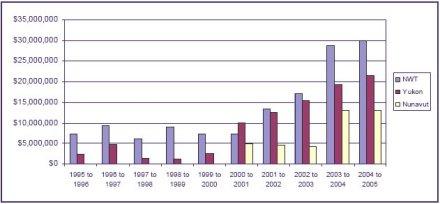
Table 5 illustrates the expenditures by site over the last three fiscal years.
Table 5: Expenditures by Site - 2002-2005
| Site Name | 2002-03 | 2003-04 | 2004-05 |
|---|---|---|---|
| Northwest Territorites | |||
| Axe Point | $32,500 | $3,056 | |
| Beaverlodge Lake | $8,142 | ||
| Colomac | $8,157,833 | $16,534,508 | $10,846,117 |
| Consolidated Beta Gama | $30,814 | ||
| Contact Lake | $4,820 | $7,200 | |
| Discovery | $398,247 | $405,922 | $3,647,465 |
| El Bonanza | $33,666 | ||
| Giant | $5,751,500 | $8,268,349 | $9,696,288 |
| Horton River | $20,000 | $41,000 | $22,528 |
| Jean Marie River | $28,155 | $14,000 | |
| Kittigazuit Bay | $800,000 | $836,000 | $763,563 |
| Port Radium | $1,500,000 | $2,126,000 | $1,859,413 |
| Rayrock | $140,000 | $105,000 | $111,362 |
| Silver Bear | $103,086 | $38,800 | $1,130,342 |
| Tundra | $71,868 | $166,451 | $1,775,778 |
| NWT Admin | $6,617 | ||
| Sub-Total | $16,975,509 | $28,583,872 | $29,927,009 |
| Site Name | 2002-03 | 2003-04 | 2004-05 |
|---|---|---|---|
| Yukon | |||
| Arctic Gold & Silver | $2,500 | $7,000 | $439 |
| Brook's Brook | $2,000 | $8,000 | $3,803 |
| Clinton Creek | $500,000 | $863,235 | $1,142,797 |
| Faro | $13,124,750 | $14,068,369 | $14,244,758 |
| Hydrometric Stations | $113,000 | $6,172 | |
| Ketza River Mine | $8,415 | ||
| Mount Nansen | $1,665,000 | $953,088 | $1,331,686 |
| Peel River | $2,000 | $14,000 | |
| Snag | $3,500 | $8,000 | $2,615 |
| UKHM | $3,766,471 | ||
| Venus Tailings | $1,500 | $6,000 | $551 |
| *Yukon Devolution | $982,000 | $536,367 | |
| Yukon Admin | $1,059 | ||
| Sub-Total | $15,301,250 | $17,022,692 | $21,045,133 |
* Expenditures under Yukon Devolution relate to hundreds of small waste sites in the Yukon that have been grouped under one name. As part of the devolution transfer agreement, $2 million/year has been earmarked for the next eight years to cleanup these sites. The CSP was only able to spend $536,367 during the 2004-2005 fiscal year.
| Site Name | 2002-03 | 2003-04 | 2004-05 |
|---|---|---|---|
| Nunavut | |||
| Akpatok Island | $2,500 | ||
| BAF 3 - Beevort | $11,300 | ||
| Bernard Harbour | $22,280 | ||
| Cape Christian | $27,900 | $29,760 | |
| Cape Peel | $22,280 | ||
| Clifton Point | $22,280 | ||
| Durban Island | $27,900 | $29,400 | |
| Ekalugad Fiord | $27,900 | $29,610 | $1,502,659 |
| Padloping Island | $27,900 | $28,550 | |
| Resolution Island | $4,015,000 | $12,766,714 | $10,220,563 |
| Roberts Bay | $75,000 | ||
| Ross Point | $22,280 | ||
| Sarcpa Lake | $2,000 | $104,247 | $1,303,185 |
| Site Assessment** | $225,000 | ||
| Nunavut Program Development | $32,566 | ||
| Sub-Total | $4,229,020 | $13,065,781 | $13,251,407 |
| Program Admin (HQ & Regional) | $599,724 | $885,843 | $2,203,184 |
| Total | $37,105,503 | $59,558,188 | $66,426,733 |
** Site assessment includes: Hope Lake, Mcgregor Lake (WK108, WK148), Speers Lake, Regan Lake, Rusty Lake, Nose Lake, Fingers Lake, Mara River Area #1, Mara River Area #2, Contwoyto Lake Area (WK111, WK129, WK131, WK135).
Figure 6 identifies the proportion of expenditures by site in 2004-2005, clearly illustrating that the large mines account for the greatest share of the program's expenditures.
Figure 6: Proportion of Expenditures by Site - 2004-2005

Figure 7 illustrates CSP expenditures by activity over the last two fiscal years. The largest proportion of expenditures in both fiscal years went towards care and maintenance and site remediation, with only marginal changes between other activities across the two periods.
Figure 7: Program Expenditures by Activity - 2003-2005


Again this year, the substantial funds received from the Federal Contaminated Sites Accelerated Action Plan (FCSAAP) enabled CSP to accomplish a number of activities at our priority sites. During the 2004-2005 fiscal year, the CSP received $45.3 million from FCSAAP, or 68% of CSP's total budget. This money went toward funding activities at 15 contaminated sites. Table 6 illustrates the remaining CSP budget that was funded by existing departmental funds. In total, CSP under spent by $905,051 of what was allocated to the Program during the reporting period.
Table 6: CSP Source of Funds 1999-2005
| Source of Funds | 1999-2000 | 2000-2001 | 2001-2002 |
|---|---|---|---|
| INAC | $9,868,747 | $21,139,607 | $8,621,000 |
| Program Integrity | $0 | $0 | $19,023,435 |
| FCSAI / FCSAAP * | $0 | $1,000,000 | $1,925,000 |
| Total | $9,868,747 | $22,139,607 | $29,569,435 |
| Source of Funds | 2002-2003 | 2003-2004 | 2004-2005 |
| INAC | $27,843,503 | $22,468,514 | $22,000,000 |
| Program Integrity | $9,262,000 | $0 | $0 |
| FCSAI / FCSAAP * | $0 | $39,439,200 | $45,331,784 |
| Total | $37,105,503 | $61,907,714 | $67,331,784 |
* Federal Contaminated Sites Assessment Initiative (FCSAI) funds were received from Treasury Board in 2000-2002 to conduct site assessment work. The Federal Contaminated Sites Accelerated Action Plan (FCSAAP) program was designed to address the significant financial and environmental liabilities associated with federal contaminated sites and began its first year of operation in 2003-2004.
Note: A total of $905,051 was not spent from what was allocated in 2004-2005.
In order to achieve our stated objectives and meet all regulatory and policy requirements, CSP has projected a future budget of $80 million for the 2005-2006 fiscal year. Figure 8 illustrates this budget forecast, which shows that remediation and care and maintenance will again absorb the majority of CSP's budget. Progress is evident by the fact that remediation is expected to exceed care and maintenance costs. If this materializes, it would represent a 58% increase over the 2004-2005 remediation expenditures for the Program.
Figure 8: Budget Forecast by Activity - 2005-2006
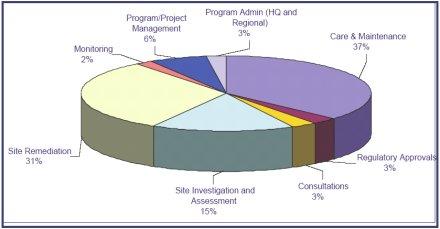
Liabilities
Contaminated site liabilities are based on engineering and site inspection reports. The Program monitors the percentage of indicative versus substantive estimates used to determine site liabilities as a measure of the quality of liability estimates. Substantive liability estimates are considered to be of higher quality and reliability. As of March 31, 2005, 14.7% of liabilities associated with the 68 NCS classified sites were substantive. This percentage has decreased from 26.6% in 2004 as a result of a new calculation method that does not include contingent liabilities. The majority of liability estimates (85.3%) are indicative, pending further assessment work.
Sites with substantive estimates:
- Colomac
- Discovery
- Radio Island
- Resolution Island
- Bear Island
- Padloping Island
- Ekalugad Fiord
- Cape Christian
- Sarcpa Lake
Liability figures may fluctuate from year to year as sites are continually undergoing various levels of assessment and remediation. As of March 31, 2005, INAC was responsible for a total liability of approximately $914 million, up from $804 million in 2003-2004, a 13.7% increase. This accounts for over 25% of the federal government's total contaminated sites liability. Most of this liability is associated with 37 sites, which have accordingly been designated as high-priority sites.
Indicative Estimate - This is a low quality, order of magnitude estimate.
Substantive Estimate - This estimate is one of sufficiently high quality and reliability. It is based on detailed system and component design and taking into account all project objectives and deliverables.
The CSP's overall liability by region and by regional proportion are presented in Table 7 and Table 8. Compared to the previous year, liabilities have increased substantially (34%) in the NWT, and changed only marginally in Nunavut (+ ~1%) and the Yukon (- ~1%). The large increase in liabilities in NWT is associated with increased liability estimates for sites such as Giant, Indore Gold Mine/Hottah Lake, Contact Lake, Discovery and Axe Point to name a few. When compared over a four-year period, however, Yukon's liability has increased by 42%. Over the same four-year period, NWT's liability has increased 26%. Nunavut's liability has experienced only a slight increase of 3% over the four-year period. Yukon's liability has increased substantially over the years due to further assessments being conducted at Faro Mine identifying increased liabilities, the UKHM site moving from a contingent liability in the previous year, as well as the substantial liability (~$18 million) associated with Yukon devolution. Nunavut's liability continues to grow slowly as further assessment work identifies new contaminated sites, and increases the estimates for other sites.
From a regional proportion perspective, the Yukon accounts for 35% of the Department's liabilities, the NWT for 47% and Nunavut for 17%. Over 60% of the program's overall liability, is associated with five of CSP's major sites - Faro Mine and UKHM (Yukon), Giant and Colomac (NWT), and Resolution Island (Nunavut).
Table 7: Liability by Region - 2001-2005
| Region | Estimated Cost of Evaluation and Remediation | ||||
|---|---|---|---|---|---|
| Liability | |||||
| 2001-02 | 2002-03 | 2003-04 | 2004-05 | % Change | |
| 2001-05 | |||||
| Yukon | $226,851,400 | $283,781,000 | $323,386,000 | $322,407,675 | 42% |
| NWT | $341,730,000 | $316,227,505 | $321,720,643 | $431,822,348 | 26% |
| Nunavut | $154,653,000 | $153,853,000 | $158,840,110 | $159,976,145 | 3% |
| Total | $723,234,400 | $753,861,505 | $803,946,753 | $914,206,168 | 26% |
Table 8: Regional Proportion of Liability - 2001-2005
Regional Proportion of Estimated Cost of Evaluation and Remediation
| Region | Liability 2001-02 |
Liability 2002-03 |
Liability 2003-04 |
Liability 2004-05 |
|---|---|---|---|---|
| Yukon | 31% | 38% | 40% | 35% |
| NWT | 47% | 42% | 40% | 47% |
| Nunavut | 21% | 20% | 20% | 17% |
| Total | 100% | 100% | 100% | 100% |
Note: Percentages may not add up due to rounding.
Social and Economic Benefits
Throughout our operations in managing contaminated sites projects in Canada's North, we strive to create positive social and economic impacts for the people within nearby communities. Our operations provide economic benefits to Aboriginal and northern communities through the procurement of goods and services to Aboriginal and northern businesses, and through the employment of local people. We also offer training programs that help to build the capacity of locals and provide opportunities to obtain future work based on the new skills developed.
Giant
INAC's focus at Giant Mine has been on care and maintenance of the site while developing a remediation plan. INAC has, either directly or indirectly through its Technical Advisor, completed extensive site assessment and baseline environmental studies, often employing local labour and contractors. Full-scale implementation of the abandonment and restoration plan at Giant Mine is not expected to begin until 2008-2009, when increased demand for local labour will occur.
Socio-economic impacts related to INAC's operations at the site are identified in the table below.
| Project Year: | 2003-2004 | 2004-2005 |
|---|---|---|
| Number of INAC employees: | 7 | 7 |
| Percentage of Northerners: | 100% | 100% |
| Number of northern suppliers: | 34 | 81 |
| Dollar value to northern suppliers: | $5,917,870 | $6,450,335 |
| Percentage value of total expenditures to northern suppliers: | 75% | 71% |
As an example, enhancing the skills of the local labour force is an objective of the program and is essential to the continued success of the Program. At Resolution Island, 95% of project staff is Inuit, and 16% of person days were dedicated to training in 2004-2005. In NWT, 148 Aboriginal/northern employees work on CSP projects. The NWT averages 77% of project staff being from Aboriginal/northern descent. In 2004-2005, 133 of CSP NWT staff received training for a total of 432 training days.
CSP projects also help support the communities where they operate by purchasing goods and services from northern suppliers. At the Giant Mine, for example, nearly 70% of suppliers are Aboriginal/ northern-owned. At Resolution Island, procurement related to the project has generated over $12 million worth of business opportunities in Nunavut since the project started in 1997.
In NWT, the Tlicho response to the use of a competitive procurement process was apprehensive at first. However, the process has proven to be fair and effective, and concerns have been allayed. CSP activities have been useful in helping to establish Aboriginal/northern companies that can now be successful bidders in competitive procurement processes across the North.
CSP projects across NWT injected $8,615,436 into the local economy through the purchase of goods and services during the reporting period. CSP projects utilized 281 Aboriginal/northern suppliers with the regional program average being 59% of the value of total expenditures going to Aboriginal/northern suppliers. Some sites, such as Horton River and Kittigazuit Bay, have close to or as high as 100% of their purchases with Aboriginal/northern suppliers.
Resolution Island
Qikiqtaaluk Corporation, an Inuit-owned company, has been contracted by INAC to conduct the clean-up of primarily PCB-contaminated soils at the Resolution Island Project. The following table illustrates the associated socio-economic benefits CSP projects can provide, such as steady employment of Inuit employed at the Resolution Island Project. The table also identifies the total amount spent on salaries over a six-year period. The total spent on salaries fluctuates depending on the amount and kind of work conducted in each year.
| Project Year: | 1999 | 2000 | 2001 | 2002 | 2003 | 2004 |
|---|---|---|---|---|---|---|
| Inuit Percentage of total workforce (%): | 78 | 80 | 82 | 85 | 91 | 95 |
| Total spent on salaries ($ ,000): | 1,350 | 1,350 | 900 | 800 | 1,700 | 2,100 |
The Resolution Island Project also contributes to business opportunities for sub-contractors and suppliers in the local economy. Procurement related to the Resolution Island Project has generated over $12 million worth of business opportunities in Nunavut since the project started in 1997. It is estimated that over 30 organizations directly benefit from the project. The project also contributes to the long-term economic development of Nunavut through training opportunities associated with the project. The following table illustrates the number of training hours provided by activity in 2004-2005.
| Activity | Hours | Activity | Hours | Activity | Hours | Activity | Hours |
|---|---|---|---|---|---|---|---|
| Heavy equipment operations | 1,412 | Electrical | 100 | Warehouse | 281 | HAZWOPER | 1000 |
| Heavy equipment mechanics | 361 | Welding | 206 | Administration | 530 | ESA | 225 |
| Small engine mechanics | 130 | Plumbing | 60 | Waste oil incineration | 120 | Environmental drilling | 25 |
| Carpentry | 140 | Cooking | 410 | Housekeeping | 1059 | Landfill construction | 350 |
The table below indicates the total number of person-days on the job versus the total number of person-days dedicated to training over the last five years.
| Project Year: | 1999 | 2000 | 2001 | 2002 | 2003 | 2004 |
|---|---|---|---|---|---|---|
| Total number of person-days: | 4,200 | 4,200 | 2,900 | 2,500 | 4,175 | 4,750 |
| Person-days dedicated to training: | 1,000 | 1,000 | 725 | 750 | 835 | 750 |
| Percentage of time dedicated to training: | 25 | 25 | 30 | 30 | 20 | 16 |
Polluter Pays
As CSP assesses the suspected sites in its inventory, the entity responsible for any contamination is determined and an attempt is made to ensure that the "polluter pays" for the clean-up.
Mine reclamation policies are in place for the NWT and Nunavut. These policies aim to protect the environment and human health in northern communities by effectively addressing the disposition of liability relating to mine closures at operating mines. [Note 4] The intent is to ensure that the "polluter pays" principle is consistently applied to all new mineral development activities to support the practice of sustainable development.
Future Directions
The CSP is committed to building on the successes achieved in 2004-2005. Future site-specific plans for the 2005-2006 fiscal year include (but are not limited to):
- Increasing expenditures on remediation at a number of sites, including Faro, Giant, Ekalugad, Port Radium, Mount Nansen, Sarcpa Lake, Tundra-Taurcanis and Simpson Lake. Overall spending on remediation is expected to increase over 25% during 2005-2006;
- Stakeholder meetings and information sessions at Faro, including First Nation participation in the development of final abandonment criteria and consultations on environmental assessment and licensing;
- Major demolition and clean-up work at Discovery;
- Further progress at Yukon Devolution sites;
- Final remediation at Resolution Island, followed by a demobilization year in 2006-2007; and
- Submission of Giant Mine's completed Remediation Plan, and ongoing care and maintenance activities.
To support these goals, future work on the management of the CSP is also important. Program goals for 2005-2006 include:
- Further work on gap analysis recommendations.
- Further implementation of the risk management procedure, including additional risk management workshops and continual improvement of the procedure and tools.
- A high-level occupational health and safety management audit against the OHASA 18001 standard, including site visits to two of CSP's most active sites to examine how health and safety systems have been implemented. The objective of this audit is to identify gaps in the current health and safety framework and to provide recommendations for implementing a Health and Safety Program.
- Ongoing maintenance and revisions of the program's Corporate Procedures, including the addition of new procedures for the Abandoned Military Sites Protocol and procurement, and possible revisions to the financial management procedure.
- A new Program Roadmap that will describe annual program requirements and provide a concise narrative of the submission and approval process. Once finalized, the roadmap will become part of the corporate procedures.
- Streamlined site level work planning and reporting.
These are only some of the specific initiatives that will take place in 2005-2006. CSP is committed to continual improvement and meeting its responsibilities of managing contaminated sites in the North according to the principles of sustainable development.
If you have any questions or comments about this report or require further information, please contact Joanna Ankersmit, Director, Contaminated Sites Program at (819) 997-7247 or by email.
List of Acronyms
CCME - Canadian Council of Ministers of the Environment
C.S. - Contaminated Sites
CSMWG - Contaminated Sites Management Working Group
CSMWT - Contaminated Sites Management Working Team
CSP - Contaminated Sites Program
DEW - Distant Early Warning
FCSAAP - Federal Contaminated Sites Accelerated Action Program
HAZWOPER - Hazardous Waste Operations and Emergency Response
HQ - Headquarters
INAC - Indian and Northern Affairs Canada
MOU - Memorandum of Understanding
NAP - Northern Affairs Program
NCS - National Classification System
NWT - Northwest Territories
PCB - Polychlorinated Biphenyls P.H. Physical Hazards
P.H. - Physical Hazards
PWGSC - Public Works and Government Services Canada
RMAF - Results-based Management and Accountability Framework
TBS - Treasury Board Secretariat
UKHM - United Keno Hill Mine
Footnotes:
- Please see the end of the report for contact information. (return to source paragraph)
- More information about the ten-step process is available online. (return to source paragraph)
- Remediation took place at 14 sites in total, but one site is classified as an NCS. (return to source paragraph)
- Mine site reclamation policies. (return to source paragraph)